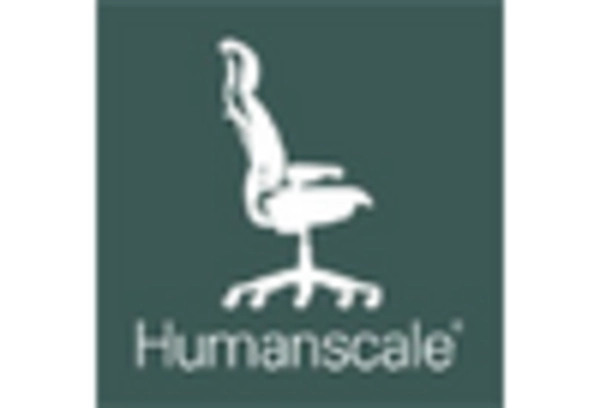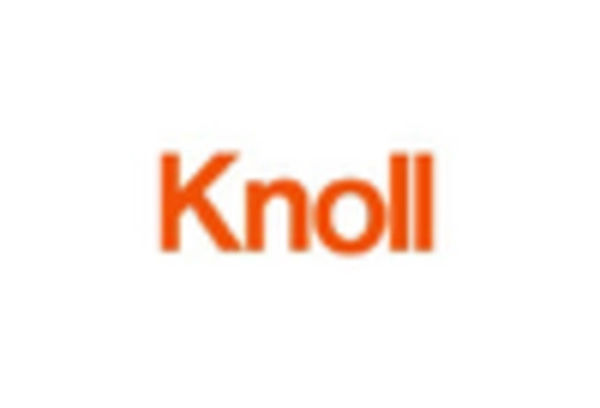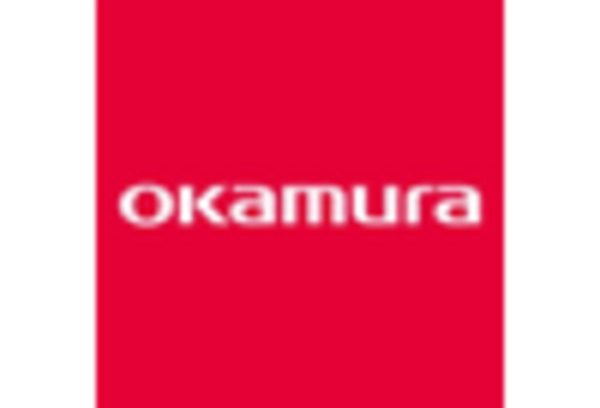The office furniture market in Europe is characterized by a dynamic competitive landscape, driven by innovation, sustainability, and evolving workplace needs. Key players such as Herman Miller (US), Steelcase (US), and Kinnarps (SE) are actively shaping the market through strategic initiatives. Herman Miller (US) emphasizes design innovation and sustainability, focusing on creating ergonomic solutions that enhance employee well-being. Steelcase (US) adopts a comprehensive approach, integrating technology into its products to foster collaboration and adaptability in workspaces. Kinnarps (SE) positions itself as a leader in sustainable practices, prioritizing eco-friendly materials and processes, which resonates with the growing demand for environmentally responsible products. Collectively, these strategies contribute to a competitive environment that increasingly values differentiation through design, sustainability, and technological integration.
The business tactics employed by these companies reflect a nuanced understanding of market demands. Localizing manufacturing and optimizing supply chains are prevalent strategies aimed at enhancing responsiveness to regional market needs. The competitive structure of the office furniture market appears moderately fragmented, with several key players exerting influence while also allowing for niche entrants. This fragmentation fosters innovation, as companies strive to capture market share through unique offerings and tailored solutions.
In October 2025, Herman Miller (US) announced a partnership with a leading technology firm to develop smart office solutions that integrate AI and IoT capabilities into their furniture designs. This strategic move underscores the company's commitment to innovation and positions it to meet the increasing demand for tech-enabled work environments. By leveraging technology, Herman Miller (US) aims to enhance user experience and operational efficiency, potentially setting a new standard in the industry.
In September 2025, Steelcase (US) launched a new line of modular office furniture designed to support hybrid work models. This initiative reflects the company's recognition of the shifting dynamics in workplace design, where flexibility and adaptability are paramount. The introduction of modular solutions allows organizations to reconfigure spaces quickly, catering to diverse work styles and preferences, thereby enhancing employee satisfaction and productivity.
In August 2025, Kinnarps (SE) unveiled its latest sustainability report, highlighting a 30% reduction in carbon emissions across its production processes. This achievement not only reinforces Kinnarps' commitment to environmental stewardship but also positions the company favorably among eco-conscious consumers. The emphasis on sustainability is likely to resonate with businesses seeking to enhance their corporate social responsibility profiles, thereby driving demand for Kinnarps' products.
As of November 2025, the competitive trends in the office furniture market are increasingly defined by digitalization, sustainability, and the integration of advanced technologies. Strategic alliances are becoming more prevalent, as companies recognize the value of collaboration in driving innovation and expanding market reach. Looking ahead, competitive differentiation is expected to evolve, shifting from traditional price-based competition to a focus on innovation, technology integration, and supply chain reliability. This transition suggests that companies that prioritize these aspects will likely gain a competitive edge in an ever-evolving market.


















Leave a Comment